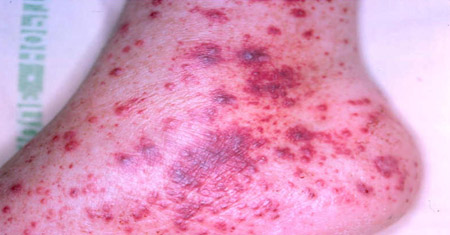History and exam
Key diagnostic factors
common
constitutional symptoms (e.g., malaise, fever, arthralgia, myalgia)
Most patients will present with complaints of arthralgias, myalgias, or malaise for several months before more specific signs or symptoms develop.
headache and scalp tenderness (giant cell arteritis)
Headache and tenderness of the scalp is characteristic of giant cell arteritis.
visual changes (large-vessel)
Amaurosis fugax, or painless vision loss (often described as like a curtain dropping over the eye), is a classic manifestation of giant cell arteritis, a form of large-vessel vasculitis.
Vision loss can be temporary or permanent.
The appearance of a blue tinge in the field of vision may be an early sign of retinal ischemia, which can also be found in large-vessel vasculitis.
upper extremity or jaw claudication (large-vessel)
More common in large-vessel vasculitis. Pain in the upper extremity or jaw after repeated use such as after chewing.
Muscle testing on examination is normal, so this feature must be elicited by the history.
Lower extremity claudication is commonly found with atherosclerosis and is not associated with vasculitis.
asymmetric brachial pulses (large-vessel)
Asymmetric pulses are often noted in the brachial arteries when, for example, a patient's blood pressure is checked in both arms.
Because the radial and ulnar arteries are small-sized vessels placed more distal from the heart, pulse asymmetry may be difficult to assess.
If a large-vessel vasculitis is being considered, check central pressures, because peripherally measured blood pressures can be misleading in these patients.
More common in large-vessel vasculitis.
bruits (large-vessel)
Carotid bruits are commonly auscultated in patients with atherosclerotic disease and are not necessarily indicative of vasculitis.
Subclavian and axillary bruits are less common and are more strongly indicative of large-vessel vasculitis.
Aortic and femoral bruits may be produced when too much pressure is applied with the stethoscope.
abdominal pain (medium-vessel)
Crampy abdominal pain, particularly after meals, may be indicative of mesenteric ischemia from a medium-vessel vasculitis.
As ischemia worsens, patients may develop hematochezia.
In older people, hematochezia is more commonly caused by atherosclerotic disease.
foot drop, wrist drop (medium-vessel)
Inability to hyperextend the hand or to dorsiflex the foot can be caused by a medium-vessel vasculitis, which leads to infarction of the radial or peroneal nerve, respectively.
Mononeuritis multiplex may also appear as a manifestation of diabetes mellitus, most likely due to a noninflammatory vasculopathy.
cutaneous ulcers (medium-vessel)
Large cutaneous ulcers, particularly over the lower extremities, may be a manifestation of medium-vessel vasculitis.
On examination these lesions are visually similar to what might be seen with pyoderma gangrenosum, mycobacterial infection, and antiphospholipid antibody syndrome.
Lesions should always be biopsied to confirm clinical suspicion.
hematuria (small-vessel)
Gross hematuria may be indicative of active glomerulonephritis, particularly if it is accompanied by proteinuria on urinalysis.
More common in small-vessel vasculitis.
palpable purpura (small-vessel)
Palpable purpura is a classic sign of small-vessel vasculitis.[Figure caption and citation for the preceding image starts]: A purpuric rashFrom the collection of Loic Guillevin, MD, Hopital Cochin, Paris, France [Citation ends].
Appears in areas where hydrostatic pressure is greatest, generally around the lower extremities and buttocks.
Rash may be preceded by a burning sensation.
otorrhea, ear pain, or muffled sensation in the ears (small-vessel)
Symptoms of granulomatosis with polyangiitis.
nasal symptoms (small-vessel)
Allergic rhinitis is a common feature in eosinophilic granulomatosis with polyangiitis. Nasal polyps, bloody nasal discharge, and nasal obstruction may also occur.
Nasal discharge and crusting, epistaxis, nasal ulcers, nasal septal perforation, and saddle nose deformity are features of granulomatosis with polyangiitis.
sinus pain (small-vessel)
Symptoms of granulomatosis with polyangiitis.
The first phase of eosinophilic granulomatosis with polyangiitis consists of allergic rhinitis, sinusitis, or asthma.
wheeze (small-vessel)
A common feature in patients with eosinophilic granulomatosis with polyangiitis. Asthma is present in 99% of patients with eosinophilic granulomatosis with polyangiitis.
uncommon
hemoptysis (small-vessel)
Hemoptysis may be found in patients with pulmonary hemorrhage from a small-vessel vasculitis (e.g., granulomatosis with polyangiitis) and may be the presenting symptom in some patients. This should be confirmed by bronchoscopy and bronchoalveolar lavage.
Risk factors
strong
extremes of age
In general, vasculitis is most common in young children and older adults.[4]
For example, giant cell arteritis is most often seen in adults >50 years of age, with one Swedish study finding that the incidence rate increased dramatically from 2.0 per 100,000 in those ages 50-60 years to 31.3 per 100,000 in those ages 71-80 years.[4][5]
In contrast, Kawasaki disease is mostly seen in children <5 years, and IgA vasculitis in children and adolescents.[4]
Use of this content is subject to our disclaimer